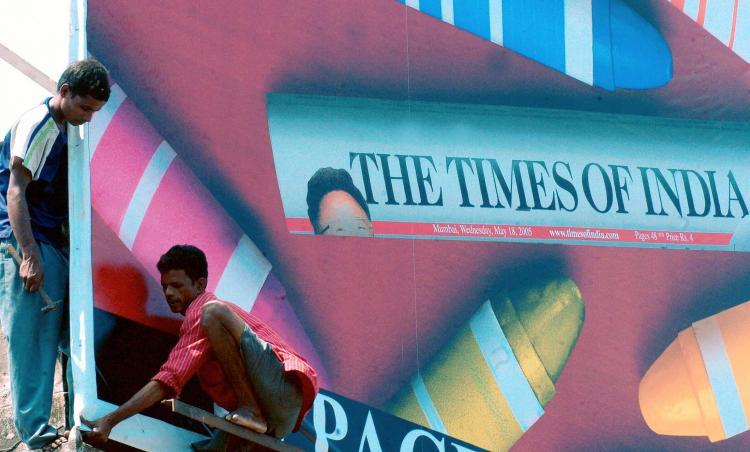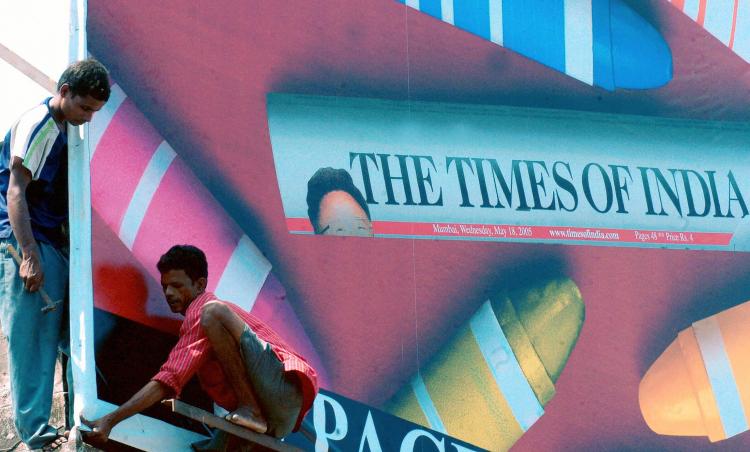In 2008, India’s television sector experienced a healthy 9.3 percent growth, although at a much slower rate than during prior years—17.1 percent in 2007 and 20.6 percent in 2006. The industry earned $1.7 billion in advertisement revenue, an 8 percent increase from 2007.
Similarly, its print media market grew by 8.7 percent with industry-wide revenues of $3.3 billion in 2008.
“Media segments that are currently experiencing declining revenues are not necessarily because of declining demand. In fact, demand for E&M [Entertainment and Media] offerings appears to be increasing. What has changed in some cases is the ability to monetize that demand,” said Jairaj Purandare of PricewaterhouseCoopers (PwC) in a recent report.
India’s media and entertainment are experiencing growth, whereas the financial, banking, IT, and telecom sectors have reduced spending and advertising.
But Indian media is still dominated by print—newspapers cornered 87 percent of India’s media market, followed with 13 percent market share by magazines. Online advertisements earned only a little over 2 percent of total industry revenues, indicating that online advertisement has not taken the same foothold as it has in the West. But online advertising revenues and market share experienced 85 percent growth last year, the highest among all advertising streams.
PwC predicts that India’s media and entertainment revenues will increase by close to 11 percent annually until 2013—far outpacing the global average of close to 3 percent during the same time period.
Cost Cutting Strategy
“E&M companies in the West have been outsourcing their work to countries like India to extract cost savings. Now, as the Indian market matures, it is the turn of E&M companies to outsource central functions … whether it is in television, radio, print, magazines, etc.,” PwC discovered.
In response to declining growth rates, Indian media companies have also gone on a cost-cutting binge, seeking to divest low-performing businesses and consolidating duplicate functions.
Some Indian companies have also been outsourcing their own operations—functions that don’t jeopardize company-specific trade secrets. Sometimes, sales, editorial, and content development functions could all be outsourced.
“The slowdown impacted the print industry more than the television industry … Newspapers and publications have reduced the number of pages to cope with the recession,” the PwC report said.
Media Woes in the U.S.
America’s print, radio, and television media profits took a 23 percent nosedive over the past two years. Industry executives don’t see any recovery on the horizon as businesses are still withholding spending and laying off employees to cut costs.
But failures to adapt to market realities during the last several years have also caught some media giants off guard.
“Journalism, deluded by its profitability and fearful of technology, let others outside the industry steal chance after chance online,” said a Pew Research Center report. “By 2008, the industry had finally begun to get serious. Now the global recession has made that harder.”
As a whole, advertising revenues—the bread and butter of media—fell by 16 percent since last year. During 2008, stocks of many publicly traded newspaper firms were down by more than 80 percent.
Newspapers, already tackling a shortage of human and other resources, are going even leaner. Some newspapers—such as Seattle’s Post-Intelligencer—stopped the presses altogether and are now trying to lure their former print newspaper customers to their Web sites. In 2008, around 5,000 newsroom jobs were cut.
“By the end of 2009, the newsrooms of American daily newspapers may employ somewhere between 20 percent and 25 percent fewer people than in 2001—with higher losses at big-city metros,” Pew researchers said.
The recent decline of newspapers does not mean that Americans are no longer reading news. Visitors to news Web sites have increased by 15.8 percent by the third quarter of 2008 compared to the same period in the prior year.
Internet advertising is also growing. PwC projects online advertising revenues to grow by close to 20 percent per year until 2012.
A deeper look shows that some advertisers have taken their ad dollars on air—television advertising has remained robust even during the recession.
“Looking across the various media sectors at audience and economic shifts, it is clear that in 2008 cable news was the big winner,” the Pew report said. “With both ad revenue and audience gains of more than 25 percent, the three cable news channels stood far above all other news media.”







Friends Read Free